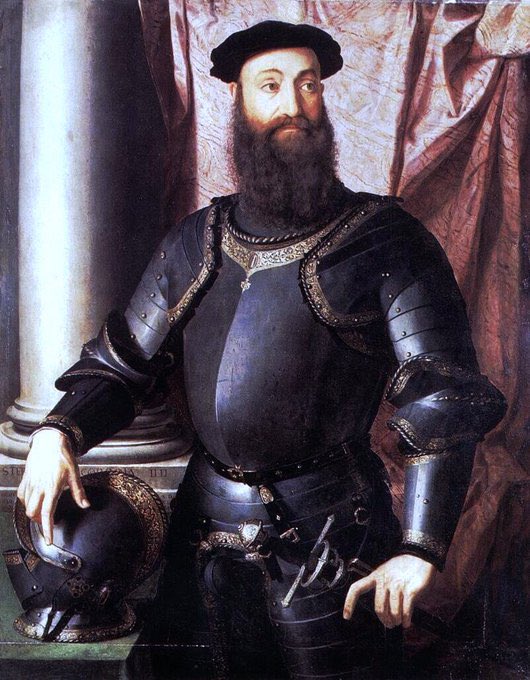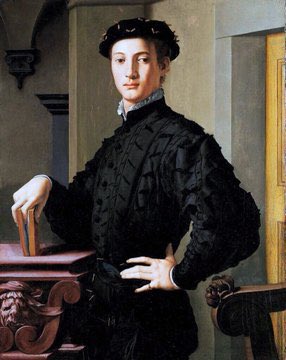Bronzino was seen as a mannerist painter in that he stretched & twisted bodies to achieve an elegant form. His religious images are fine examples of that. The Virgin (1555), Cosimo I de’ Medici (1559), Noli Me Tangere (1561) & Allegory of Happiness (1564)
His mythological portraits are fascinating, in that wanting to be learned, his male sitters inadvertently presented themselves as homoerotic images. Portrait of Andrea Doria as Neptune (1550-5), St John the Baptist (1550-5), The Resurrection (1550) & Francesco I de’ Medici (1551)
Bronzino’s portrait of Colonna is an essay in masculinity, as well as humour. That humour also appears in his ‘baby’ portraits. Stefano IV Colonna (1546), Don Garcia de’ Medici (1550), Holy Family (c1550) & Portrait of a Lady (1550). The latter is one of his warmest works
From 1540-1 Bronzino was working on the fresco of the Chapel of Eleanora di Toledo in the Palazzo Vecchio. To experience this room is a highlight of a visit to Florence. It’s a fine hybrid of his religious & sensual approach
One of Italian art’s most sublime portraits is of Lucrezia Panciatichi where the sitter’s exquisite looks are presented in an elongated lyric fashion. Ugolino Martelli (1535), Portrait of a Young Man (1540), Bartolomeo Panciatichi (1540) & Lucrezia Panciatichi (1540)
Born in Florence, the son of a butcher, he was apprenticed to Pontormo in 1517, aged 14. Pontormo had a large influence on his student. St Mark (1525), St Matthew (1525) & St Sebastian (1525-8). He approached the male nude with sensuality
Goncharova became a French citizen in 1938. Costume (1935), Book Covers (1936-7) & Ballet Souvenir Cover (1936-7). It’s notable that her illustrations are much more conservative than her paintings yet are captivating.
Her image of women is startlingly modern - it could be from the 1980s! Yet the Still Life might be 1950s. Both works show her as a woman decades more advanced than the zeitgeist. Amazing! Women (1928), Still-Life (1929), Mirage (1930) & Abstract (1930)
What’s fascinating about Goncharova is her ability to jump from art style to style at the same time. Such diversity is really rare (Picasso did the same). Composition (1920), Two Russian Maidens (1920), Composition (1920) & Landscape (1920)
From 1911 she was a key member of the Blaue Reiter. Curtain for Le Coq d’Or (1914), St George the Victorious (1914), Forest (Red-Green), 1914 & Composition (1914). The Blue Rider Group was the most significant expressionist one. She also explored Fauvism.







































